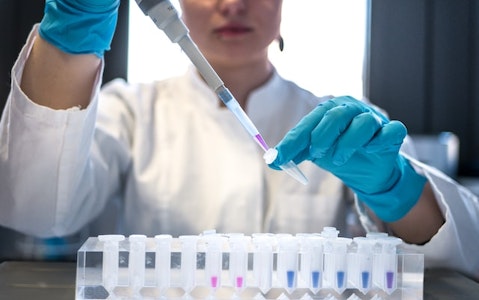Achieve Life Sciences, Inc. (NASDAQ:ACHV) Q3 2022 Earnings Call Transcript November 14, 2022
Achieve Life Sciences, Inc. misses on earnings expectations. Reported EPS is $-1.35 EPS, expectations were $-1.13.
Operator: Good day, ladies and gentlemen, and welcome to Achieve Life Sciences Third Quarter 2022 Earnings Conference Call. All lines have been placed on a listen-only mode. And the floor will be open for questions and comments following the presentation. At this time, it is my pleasure to turn the floor over to your host Nicole Jones, CG Capital Investor Relations. Ma’am, the floor is yours.

Photo by Julia Koblitz on Unsplash
Nicole Jones : Thank you, operator. On today’s call from Achieve we have John Bencich Chief Executive Officer; and Jerry Wan Principal Accounting Officer. Achieve management will be available for Q&A after the prepared remarks. I’d like to remind everyone that today’s conference call contains forward-looking statements based on current expectations. These statements are only predictions and actual results may vary materially from those projected. Please refer to Achieve document available on our website and filed with the SEC concerning factors that could affect the company. I’ll now turn the call over to John.
John Bencich: Thank you, Nicole and thanks everyone for joining us today. It was yet again a busy and exciting quarter for Achieve. As we continue to advance cytisinicline through the clinic and closer to becoming the first new prescription treatment for nicotine dependence in nearly two decades. In September, we announced completion of target enrollment in our confirmatory Phase III ORCA-3 trial for smoking cessation. And just last week we announced the earlier-than-expected completion of enrollment in our Phase II ORCA-V1 trial for nicotine e-cigarette or vaping cessation. As a reminder, the ORCA-3 trial is the second and final randomized Phase III trial required for FDA submission and ultimately marketing authorization in the US.
The design mirrors that of the previous ORCA-2 trial that read out with overwhelmingly positive results earlier this year. Both trials were designed to evaluate the smoking cessation efficacy, safety and tolerability of 3-milligram cytisinicline dosed three times daily over a period of either 6 weeks or 12 weeks compared to placebo. The trials also share the same primary endpoint to evaluate smoking abstinence during the last four weeks of treatment which is the FDA’s approvable endpoint for smoking cessation medications. The outcome of ORCA-2 further enhanced our belief that cytisinicline if approved has strong potential to become the new gold standard for the treatment of nicotine dependence. With single-digit rates of adverse events cytisinicline side effect profile is substantially better than what has been seen in currently available treatments.
From an efficacy perspective, the odds ratios we observed in ORCA-2 were unprecedented with six times to eight times higher odds of quitting at the end of treatment compared to placebo. Additionally, our quit rates were impressive despite the highly addictive study population and the execution of the trial during a pandemic. We hope to see similar results from ORCA-3 and look forward to sharing those with you in the second quarter of 2023. Vaping continues to be an important topic on a global scale, particularly with the alarming rate of adolescent users and new data reporting the potential harmful impacts to cardiovascular and respiratory health. The CDC released data last week indicating more than 2.5 million high school and middle school students were current users of e-cigarettes in the US alone.
There are also more than 11 million adult users of nicotine vape products in the US and no treatments are currently approved specifically for vaping cessation. We pursued the ORCA-V1 trial with the expectation that cytisinicline would be of interest to this growing and underserved population. The swift recruitment of ORCA-V1 appears to reinforce our assumptions of the demand for treatment within this population. Recruiting at only five clinical trial sites, ORCA-V1’s target enrollment of 150 subjects was completed in roughly four months. Regarding the design ORCA-V1 will evaluate 12 weeks of cytisinicline versus placebo. As with the other ORCA trials all participants will receive behavioral support throughout the study. The primary objective will be to evaluate for successful nicotine vaping cessation defined as weekly abstinence for the last four weeks of treatment with cotinine levels as biochemical confirmation of abstinence.
Top-line data for ORCA-V1 is also expected to be reported in the second quarter of 2023. With the two trial enrollment milestones behind us, we turn our attention to three key priorities over the coming months. First, continuous engagement with the ORCA-3 and ORCA-V1 clinical trial sites and our third-party clinical research organization to, ensure data reporting accuracy and adherence to time lines. Second, extensive preparations to support an NDA filing in the U.S., post successful ORCA-3 trial results, including the completion of the remaining supportive trials required for filing. Third, commercial readiness including, launch preparedness activities and partnering discussions with interested parties who also believe in the immense potential of cytisinicline.
Also, as part of our commercial readiness objective, we continue to work closely with our manufacturing partner Sopharma, to ensure adequate commercial capacity at launch. As we announced today, Sopharma recently invested more than €3 million to complete the build-out of a new dedicated cytisinicline API purification suite and its primary manufacturing plant in Sofia. The new API suite complements Sopharma’s capacity to produce nearly three billion tablets annually. I would now like to turn the call over to Jerry, for the third quarter financial update.
See also 10 Best Widow and Orphan Stocks To Buy and Jim Cramer’s Comeback Stocks.
Jerry Wan: Thank you, John. I will be providing an update on our cash position as of September 30th 2022 and reviewing our operating expenses for the third quarter. As of September 30th 2022, the company’s cash, cash equivalents, short-term investments and restricted cash were $18.2 million, compared to $43 million as of December 31st 2021. Our cash forecast includes reimbursements from the awarded $2.5 million grant, received from the NIH to support the Phase 2 ORCA-V1 trial, to evaluate the use of cytisinicline as a treatment for cessation of nicotine e-cigarette use. As a reminder, approximately half of the cost from the, ORCA-V1 trial are funded through the grant from the NIH. With respect to our statement of operations, net loss increased to $13.1 million for the quarter ended September 30th 2022, compared to $6.7 million for the same quarter of 2021.
Net loss for the nine months ended September 30th 2022 increased to $31.1 million, compared to $26 million for the same period of 2021. Operating expenses increased in the third quarter, with the achievement of targeted enrollment in our ORCA-3 trial and initiation and enrollment in our ORCA-V1 trial. We expect our quarterly operating expenses will remain elevated in the fourth quarter of this year before reducing in the first half of 2023, as the ORCA-3 and ORCA-V1 trials reach completion. That concludes my financial remarks. And I will now turn the call back over to John.
John Bencich: Thanks, Jerry. 2022 has been a pivotal year for Achieve, with key highlights being the successful Phase 3 trial results and completing enrollment in two other important studies. We are pleased that we continue to deliver on our milestones and the commitments we have made to bringing forward this important new treatment. Smoking and nicotine addiction directly impacts more than one billion people around the globe. In the U.S. alone, there remain more than 30 million people who smoke and nearly 0.5 million people die each year, due to smoking-related illnesses. In an analysis, we recently conducted with current smokers who want to quit, 80% overall, stated they would be interested in a new smoking cessation products.
In the segment we believe will be most appropriate for cytisinicline, 93% desired something new. The current treatments that are available have a high dissatisfaction rating for both smokers and prescribers and new options are long overdue. More needs to be done to help people who want to quit and to improve and extend their lives. We believe we have a unique opportunity and responsibility to make a real difference with cytisinicline. Again, thanks all for your continued support and joining us today. I’d now like to turn the call over to the operator, and open the line for questions.
Q&A Session
Follow Achieve Life Sciences Inc. (NASDAQ:ACHV)
Follow Achieve Life Sciences Inc. (NASDAQ:ACHV)
Operator: Thank you. The floor is now open for questions. And our first question comes from Thomas Flaten from Lake Street Capital. Go ahead, Thomas.
Thomas Flaten: Hey guys. Thanks so much for taking my questions and congrats on all the progress. I was just curious John any insight into — and I might have missed this I apologize publication of ORCA-2.
John Bencich: Thanks, Thomas. Appreciate the question. So, this is an activity that, we are actively engaged in, in particular with Dr. Nancy Rigotti, who is the primary investigator on the ORCA-2 trial. So, we currently have a draft manuscript that’s being reviewed and we hope to get that submitted in the near future.
Thomas Flaten: And then on the Sopharma expansion, was that done specifically to support your pending approval and launch?
John Bencich: That’s correct. So the new API suite that was just recently completed that is 100% dedicated to cytisinicline and that was in furtherance of making sure that we’ve got appropriate throughput as we look to move this program forward to market.
Thomas Flaten: And I’m assuming you guys are going to do a pre-NDA meeting with FDA and if that’s incorrect, please let me know. And is it your intention to discuss with them the ability to squeeze in the vaping data into a potential label expansion this early, or do you think there’s other steps that are required in the interim?
John Bencich: Yeah. Let me hand that one over to Dr. Jacobs.
Cindy Jacobs: Hi. Yes, we will be looking at including the vaping study of safety data. We won’t have enough efficacy, because that’s a small Phase II, but what we would be doing is discussing with the FDA after we get approval for smoking cessation that we would only need to have one Phase III study to add then vaping onto the indication in the label.
Thomas Flaten: Excellent. Thanks, guys. Appreciate you taking the questions.
John Bencich: Thanks, Thomas.
Operator: Thank you. And our next question comes from François Brisebois from Oppenheimer. Go ahead, François.
François Brisebois: Thank you for taking the question here. So I just was wondering, how are you seeing generics doing? And it’s doing pretty well how do you see any read-through for your product? And then just any updates on chance that’s being removed from the market here?
John Bencich: Yeah. Thanks, Frank. So we have been monitoring the first generic entrant which has been from Endo Pharma and they did put out their Q3 earnings and I think as we’ve indicated previously they look to be on a run rate to achieve $300 million in sales here in 2022. And that is roughly 50% of the script volume that, we saw with CHANTIX, before it was withdrawn from the market last year. And keep in mind that, Endo doesn’t have reps on the ground. They’re not marketing this in a way that a branded product would be. So I think that’s quite impressive to see a run rate like that, with what we’ve seen to be a fairly disliked product in vertical. In terms of CHANTIX, the brand coming back to the market we haven’t seen any new indications from Pfizer in terms of a timing for that. So at the moment, it continues to be off the market in terms of the brand and we’ll continue to monitor to see if that changes here in the future.

